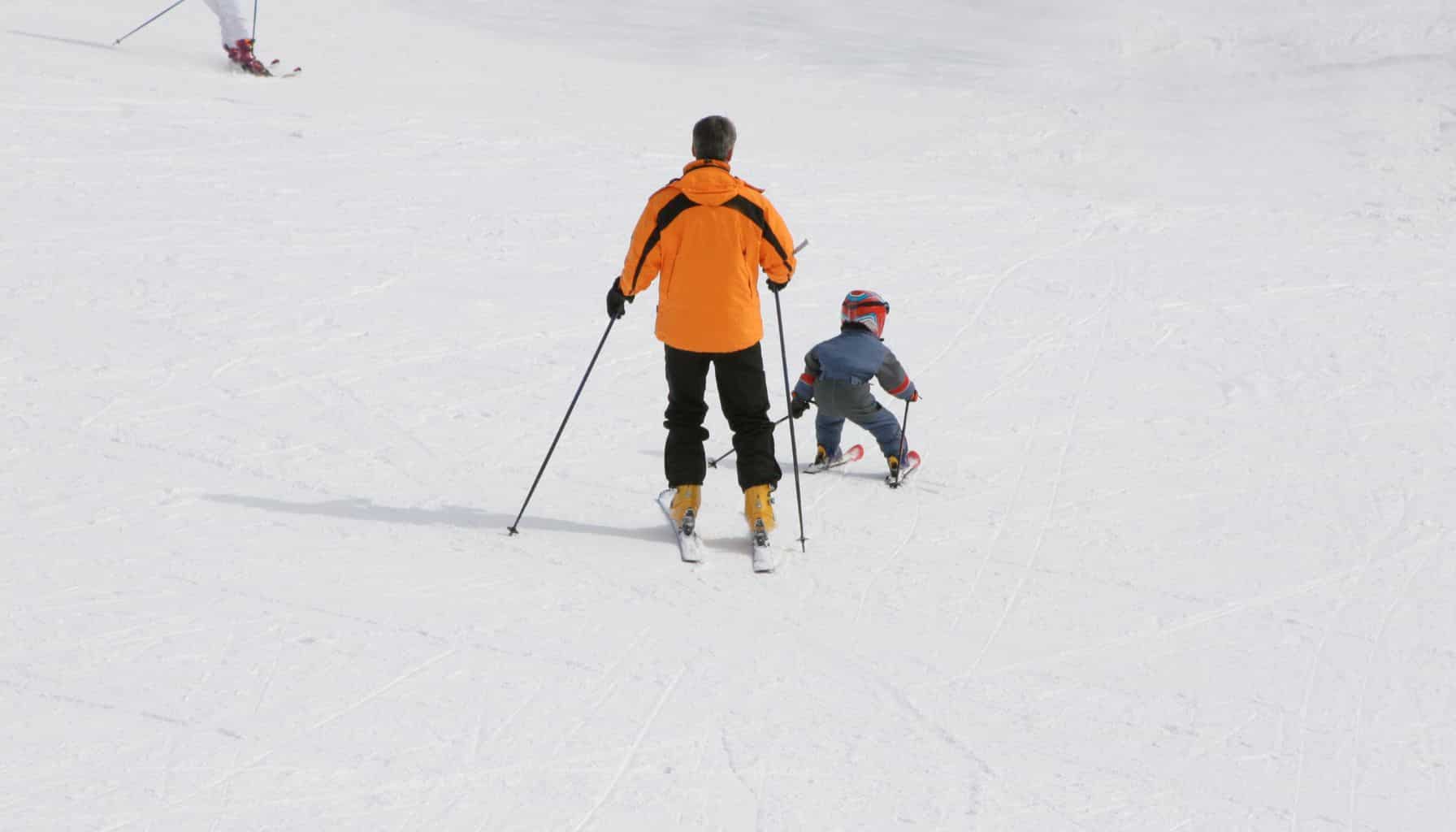Skiing and snowboarding are delightful ways to enjoy winter, and for parents looking to immerse their toddlers in skiing and snowboarding, ensuring safety is paramount. Among the essentials for novice young skiers, the best ski harness for toddlers stands out as a crucial tool. This accessory aids in creating a secure environment on the slopes, allowing youngsters to build confidence and learn the ropes of skiing. In this review, we will explore the top ski harnesses available, guiding parents to make an informed decision about the best ski harnesses tailored to the needs of their little skier.
Top Ski Harnesses for Toddlers
Navigating the market for the ideal ski harness can be a bit overwhelming with so many options available. Here’s a breakdown of the top choices tailored to the needs of young skiers:
Slope Ropes Ski Trainer: The Easiest Way to Learn
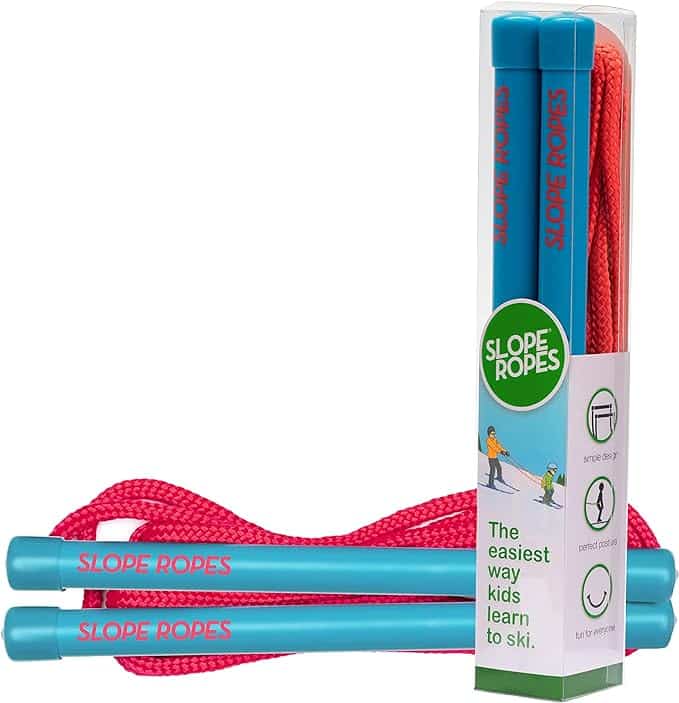
The Slope Ropes Ski Trainer emerges as an innovative solution aimed at revolutionizing the way toddlers learn to ski. Unlike traditional harnesses that can sometimes limit movement or encourage dependency, Slope Ropes offers a unique approach to ski training that promotes independence and balance from the get-go.
Description
Slope Ropes Ski Trainer is designed with simplicity and effectiveness in mind. It’s essentially a rope-based system that encourages correct ski posture and balance in a natural and intuitive way. The product includes a durable, high-quality rope with handles at both ends—one for the child and the other for the parent or instructor.
This setup allows for easy guidance and control while giving the child the freedom to explore skiing mechanics on their own terms. The design is focused on promoting a forward-leaning stance and proper skiing form, which are critical for developing fundamental skiing skills.
Pros
- Promotes Natural Learning: By allowing children to maintain a natural stance and balance, Slope Ropes facilitates a more effective learning process compared to more restrictive harnesses.
- Easy to Use: The simplicity of the Slope Ropes system means it can be quickly set up, making it ideal for busy ski days when time is of the essence.
- Enhances Safety: Parents retain control over their child’s speed and direction, reducing the risk of accidents on the slopes.
- Portable and Lightweight: Slope Ropes is easy to carry and won’t add significant weight to your ski gear, making it a convenient option for on-the-go families.
- Versatile: Suitable for children of various ages and skill levels, making it a versatile addition to your ski training toolkit.
Cons
- Limited Distance Control: Unlike harnesses with longer leashes, Slope Ropes keeps the child quite close to the parent, which might not be suitable for more advanced learners ready for greater independence.
- Requires Active Parent Participation: The system demands that the parent or instructor be an active participant in the learning process, which might be challenging for those less confident in their own skiing abilities.
Review
The Slope Ropes Ski Trainer stands out for its innovative approach to ski training for young learners. Its focus on promoting natural balance and proper skiing posture sets it apart from more traditional, restrictive harness systems. The ease of use and the enhanced safety features make it an attractive option for parents looking to support their child’s skiing development in a hands-on manner. Furthermore, its lightweight and portable design ensure that it won’t be a burden to bring along on your skiing adventures.
While the close proximity required between the child and the parent may not suit every learning stage, especially as the child gains confidence and skill, it provides an invaluable tool during those initial, formative experiences on the slopes. The need for active parent participation can also be seen as an advantage, fostering a shared learning experience and offering opportunities for bonding and fun on the ski slopes.
Overall, the Slope Ropes Ski Trainer is an excellent choice for families seeking a simple, effective, and engaging way to introduce their children to skiing. Its benefits in promoting correct form and ensuring safety on the slopes make it a standout option worth considering for your next winter sports season.
Buy The Ski Ropes On AmazonMDXONE Ski Harness Trainer with Shock-Absorb Leashes
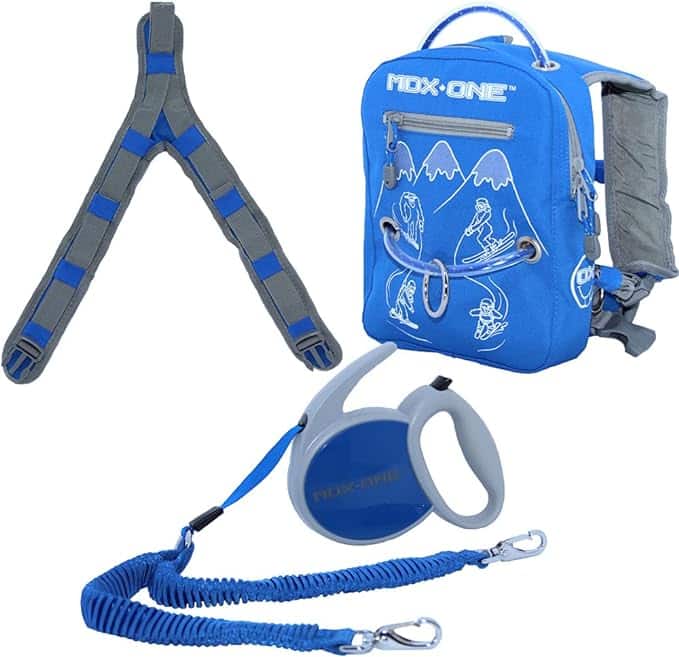
The MDXONE Ski Harness Trainer is designed to make the learning process for young skiers not just safer, but more engaging and efficient. This innovative ski harness combines the benefits of direct parental control with the freedom for toddlers to explore skiing dynamics on their own terms. Here’s a breakdown of its features, pros, cons, and overall review to help you decide if it’s the right choice for your little skier.
Description
The MDXONE Ski Harness Trainer is a comprehensive tool for teaching toddlers and young children how to ski. Made from durable materials, it features a comfortable, adjustable harness that fits snugly around the child, ensuring safety without hindering movement. The harness is connected to shock-absorbing leashes that allow parents to control speed and encourage turning, while also softening any sudden tugs or stops. The shock-absorb feature is particularly innovative, reducing the jerky motions that can sometimes startle young learners or affect their balance.
Pros
- Safety and Control: The shock-absorb leashes provide a smooth experience, allowing for gentle guidance or quick interventions when necessary.
- Comfort and Adjustability: Designed with the young skier’s comfort in mind, the harness is adjustable to fit a wide range of sizes and is padded for extra comfort.
- Independence for the Learner: By offering just enough freedom for the child to feel independent, it promotes confidence and accelerates the learning process.
- Ease of Use: The harness is straightforward to put on and adjust, ensuring a hassle-free start to the ski day.
- Versatility: Suitable for both skiing and snowboarding, making it a versatile choice for families with diverse winter sports interests.
Cons
- Learning Curve for Parents: Some parents may need time to get used to the best ways to utilize the leashes for optimal teaching.
- Price: The MDXONE Ski Harness Trainer is an investment. Its price point may be higher than some other teaching tools on the market.
Review
The MDXONE Ski Harness Trainer stands out in the crowded field of ski teaching tools for toddlers. Its thoughtful design addresses the primary concerns of both safety and learning effectiveness. The shock-absorbing leashes are a standout feature, ensuring that the child’s first experiences on the slopes are as smooth as possible. This harness acts not just as a safety device but as a true learning aid, encouraging proper posture and balance, which are crucial for developing skiing skills.
Parents will appreciate the peace of mind that comes from having direct control over their child’s speed and direction, while children will enjoy the sense of independence and achievement as they navigate the slopes. The adjustability and comfort of the harness ensure that it can grow with your child over multiple seasons, making it a worthwhile investment.
While the price may be a consideration, the durability, versatility, and effectiveness of the MDXONE Ski Harness Trainer offer significant value. For families dedicated to introducing their children to skiing or snowboarding in a safe, controlled, and enjoyable manner, this product is an excellent choice.
The MDXONE sets itself apart with its focus on shock absorption, which significantly enhances the learning experience. It’s a thoughtfully designed tool that respects the learning curve of young skiers, making it a top recommendation for parents looking to support their child’s skiing journey.
Buy The Ski Ropes On AmazonLucky Bums Ski Harness
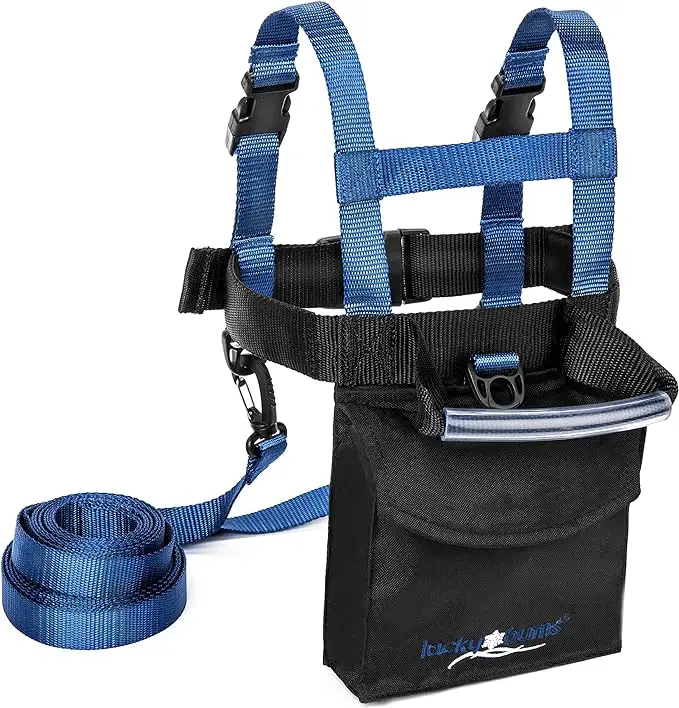
The Lucky Bums Ski Trainer Harness combines simplicity with functionality, providing a safe and controlled environment for young skiers to learn and develop their skills. Below is a detailed description of the product, along with its advantages, potential drawbacks, and an overall review to help you determine its suitability for your child’s skiing adventures.
Description
Designed with beginner skiers in mind, the Lucky Bums Ski Trainer Harness is all about safety and comfort. The harness wraps around the child’s torso, offering adjustable straps for a snug and secure fit, regardless of the child’s size or the number of layers they’re wearing.
It features a handle on the back for easy lift and maneuvering in chairlifts or after falls. The standout feature of this harness is its leash system, which allows parents to control speed, encourage turning, and ensure their child doesn’t stray too far ahead or pick up too much speed on beginner slopes.
Pros
- Enhanced Safety Features: The inclusion of a handle at the back of the harness ensures parents can easily lift their child when needed, adding an extra layer of safety and convenience.
- Parental Control: With the leash system, parents can directly control their child’s movements on the slopes, providing a safer learning experience.
- Adjustable Fit: The harness is designed to be fully adjustable, ensuring a comfortable and secure fit for children of various sizes.
- Ease of Use: The Lucky Bums Ski Trainer Harness is easy to put on and take off, making it convenient for busy skiing days.
- Builds Confidence: By keeping the child close and providing them with a sense of security, the harness helps build confidence in young skiers.
Cons
- Potential for Dependency: Like any ski harness, there’s a risk that children may become overly reliant on the leash system for balance and control, which could delay the development of independent skiing skills.
- Limited Independence: While the leash system offers significant safety benefits, it also means children have less freedom to explore skiing independently, which could be a downside as they gain more experience.
Review
The Lucky Bums Ski Trainer Harness is a solid choice for parents seeking a straightforward and effective way to teach their toddlers how to ski. Its focus on safety, combined with the ease of use, makes it an appealing option for many families. The harness’s design ensures that children are kept safe and secure, while the leash system gives parents peace of mind by allowing them to maintain control over their child’s speed and direction on the slopes.
While the harness is a valuable tool for beginners, it’s important for parents to gradually encourage their children to ski independently, to prevent over-reliance on the harness. Integrating leash-free skiing sessions as the child becomes more comfortable and skilled can help mitigate this concern.
The Lucky Bums Ski Trainer Harness stands out for its simplicity, effectiveness, and focus on safety. It’s an excellent investment for families introducing their children to skiing, offering a blend of control for parents and a secure learning environment for kids. Whether it’s your child’s first time on the slopes or they’re refining their skills, this harness provides a supportive framework for their skiing development.
Buy The Ski Ropes On AmazonSklon Ski Harness
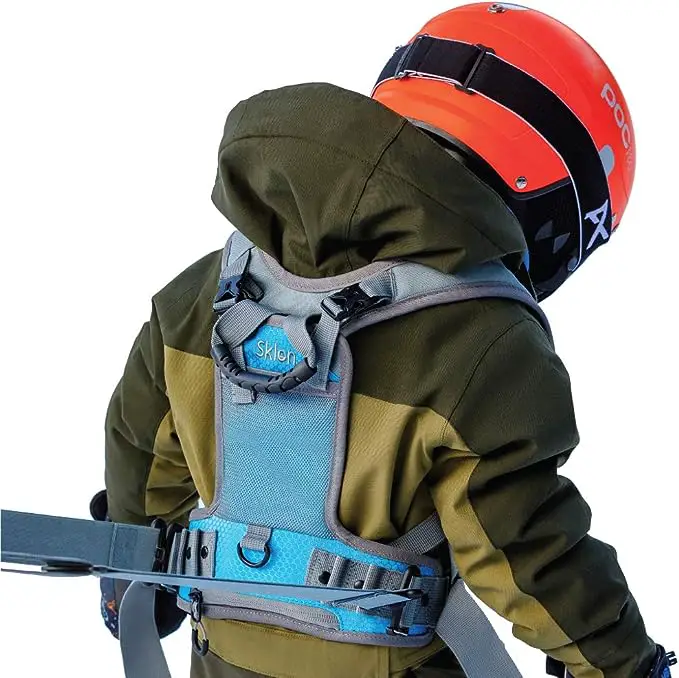
The Sklon Ski and Snowboard Harness Trainer is an innovative and supportive device designed to help young skiers and snowboarders gain confidence and skills on the slopes. With its focus on safety and learning, the Sklon Harness provides parents with a reliable tool to guide their children through the early stages of skiing or snowboarding. Here’s an in-depth look at its features, benefits, drawbacks, and overall performance.
Description
The Sklon Harness is crafted with the beginner skier or snowboarder in mind, offering a sturdy, comfortable, and adjustable harness system that fits children of various sizes. It features multiple attachment points, ensuring that children are supported in the correct posture for skiing or snowboarding. The harness includes an adjustable back height, making it a versatile choice for growing children. Additionally, it comes with bungee leashes that allow for gentle guidance down the slopes, giving the child a sense of freedom while still under the parent’s control.
Pros
- Adjustable Fit: With its adjustable back height and straps, the Sklon Harness can easily grow with your child, providing multiple seasons of use.
- Multiple Attachment Points: This feature allows for customized control and support, ensuring the child is in the correct position for learning.
- Comfort and Safety: The harness is designed for comfort, with padding in key areas to prevent chafing. The bungee leashes offer a smooth experience, reducing jerks and sudden stops.
- Versatility: Suitable for both skiing and snowboarding, making it an ideal choice for families who enjoy both winter sports.
- Ease of Use: Parents will find the harness easy to adjust and the leashes simple to manage, even on busy slopes.
Cons
- Learning Curve: Some parents may need time to familiarize themselves with the best way to use the multiple attachment points for optimal teaching.
- Price: As with many high-quality ski training tools, the Sklon Harness is an investment, which might be a consideration for some families.
Review
The Sklon Ski and Snowboard Harness Trainer shines as a comprehensive solution for young winter sports enthusiasts. Its emphasis on adjustability and comfort makes it stand out, ensuring that children are not only safe but also feel at ease while learning. The multiple attachment points are a significant advantage, offering tailored support that can adapt to the child’s learning curve and the parent’s teaching style.
Parents will appreciate the versatility of the Sklon Harness, especially if their children are interested in both skiing and snowboarding. The bungee leashes are a thoughtful addition, providing enough give to encourage independence while keeping safety a top priority.
While the initial investment may be higher than some alternatives, the durability, adjustability, and overall quality of the Sklon Harness offer significant value over time. It’s a tool that can support a child’s journey from their first day on the slopes to becoming a confident skier or snowboarder.
The Sklon Harness stands out for its versatility and the level of control it offers. It’s an excellent choice for parents looking for a safe, effective, and adaptable way to teach their children the joys of skiing and snowboarding.
Buy The Ski Ropes On Amazon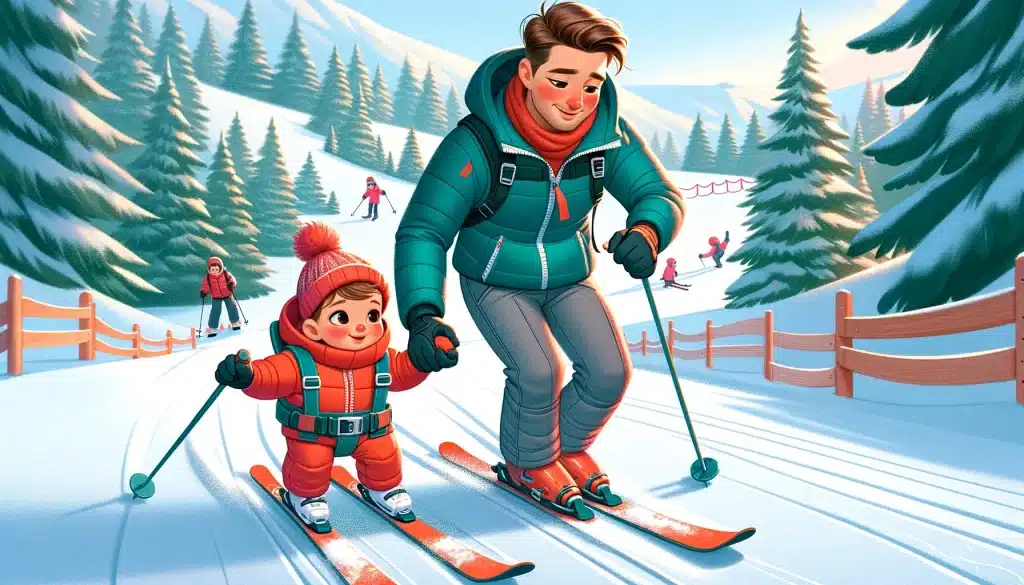
What to Look for When Buying a Ski Harness?
Choosing the right ski harness for your toddler is crucial for ensuring safety, comfort, and an effective learning experience. Here are some key considerations to keep in mind when making your selection:
1. Fit and Adjustability:
- A good ski harness should offer a snug fit without being overly restrictive. Look for adjustable straps that can be customized according to your child’s size and the clothing layers they have on.
2. Material and Durability:
- Opt for harnesses made of durable, high-quality materials that can withstand the wear and tear of snowy environments. Weather-resistant features, such as waterproofing, can also be beneficial.
3. Leash System:
- The leash should be easily detachable and of an adequate length to give the parent control without causing them to bend or hunch over. Some harnesses offer dual leashes for better steering.
4. Comfort:
- Ensure the harness has sufficient padding, especially in areas that come into direct contact with your child, like the backplate.
5. Safety Features:
- Reflective elements can be a plus for visibility in low-light conditions. Additionally, some harnesses come with emergency whistles or other safety tools.
6. Ease of Use:
- A ski harness should be intuitive to put on and take off. Look for harnesses with clear instructions and easy-to-use buckles and attachments.
7. Additional Features:
- Some harnesses come with pockets or pouches, which can be handy for carrying small items like snacks or sunscreen. Others might have a handle, making it easier to assist your child on chairlifts or help them up after a fall.
8. Reviews and Recommendations:
- It’s always helpful to check customer reviews to gauge the real-world performance of a ski harness. Personal recommendations from friends or a former ski instructor can also guide your decision based on what worked for their kids or ski school.
9. Price:
- While it’s essential to ensure the quality and safety of the harness, there are options available at various price points. Determine a budget but prioritize the features that are most important to you and your child’s skiing experience.
10. Brand Reputation:
- Established brands in the skiing industry tend to have a history of producing reliable equipment. Researching brands can provide added assurance about the product’s quality and the company’s commitment to safety.
By taking the time to consider these aspects and compare various ski harnesses on the market, parents can feel confident in selecting a product that aligns with their child’s needs and ensures a positive skiing experience.

Why Use a Ski Harness for Toddlers?
The notion of putting your toddler on skis might be a bit nerve-wracking. But with the right equipment, this experience can be both safe and enjoyable. A ski harness serves several key purposes:
- Safety: The primary benefit is safety. Ski harnesses are designed to provide control for parents, enabling them to guide and stop their children as needed. This ensures that young skiers won’t stray too far or pick up excessive speed, especially on beginner slopes.
- Confidence Boost for Children: Using a ski harness can provide toddlers with the confidence to try skiing. Knowing that they have the support and guidance from their parents can make the experience less intimidating.
- Aid in Teaching Skiing Basics: The harness is not just a safety tool; it’s a teaching aid. Parents can gently guide their toddlers, helping them understand the basics of balancing, turning, and stopping.
By understanding the benefits of a ski harness, parents can make an informed decision on its necessity and how it can enrich the skiing experience for their toddlers.
How to Properly Use a Ski Harness
Ensuring that a ski harness is used correctly is as crucial as selecting the right one. Here’s a step-by-step guide to ensure both safety and comfort:
Correct Fitting on a Toddler:
- Begin by placing the harness on your child without any winter clothing to get a baseline fit.
- Adjust the straps so they snugly fit around the child’s torso without being too tight. Remember, you’ll need to account for the added bulk of winter clothes.
Role of Handle and Straps:
- The handle, usually located at the back, is designed for quick interventions, helping lift your child after a fall or during chairlift rides.
- The leash straps, attached at either side or the back, give parents control over their child’s movement and speed. Make sure they’re securely fastened and at a length that offers control without causing tripping hazards.
Safety Precautions While Skiing:
- Always start on beginner slopes to familiarize your toddler with the sensation of skiing and the function of the harness.
- When using the leash system, ensure you maintain a stable stance, keeping your weight centred to avoid getting pulled over.
- Be mindful of other skiers. Ensure you and your child maintain a safe distance to avoid any collisions or interruptions.
- Regularly check the harness for any signs of wear or damage before hitting the slopes.
By adhering to these guidelines, parents can ensure a positive and safe skiing experience for their toddlers, maximizing the benefits of the harness while minimizing potential risks.
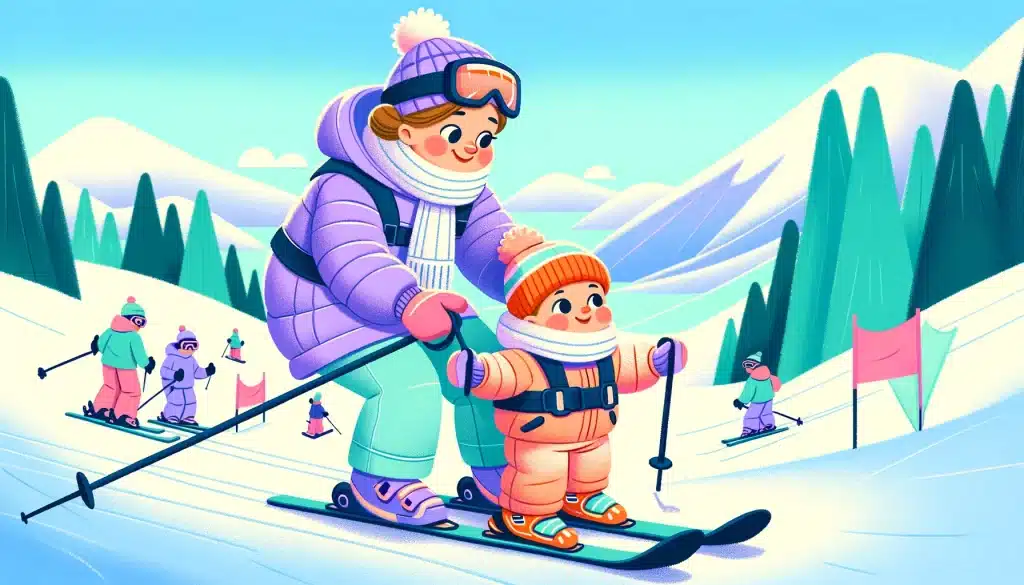
Things to Watch for When Using a Ski Harness
While ski harnesses can be incredibly beneficial, it’s essential to be aware of certain aspects to ensure the safety and comfort of your toddler:
Fit and Comfort:
- Continuously monitor the fit of the harness. Growth spurts can make a once perfectly fitting harness too tight.
- Check for any signs of chafing or discomfort. Areas under the arms or around the waist can be particularly sensitive.
Over-reliance on the Harness:
- While the harness is a great tool, it’s crucial that toddlers learn to balance and ski independently. Gradually let them ski short distances without relying on the leash.
- Encourage them to get up on their own after a fall, instead of always lifting them using the handle.
Weather and Equipment Checks:
- In extreme cold, plastic or metal components of the harness can become brittle. Always check the harness’s integrity in colder temperatures.
- Ensure that the harness isn’t interfering with other ski equipment, like ski boots or poles if they’re being used.
Awareness of Surroundings:
- Stay vigilant about other skiers and snowboarders. Using a harness might mean that you’re taking wider turns or moving more slowly, so ensure you’re not obstructing the path for others.
- When skiing in areas with trees or other obstacles, ensure the leash or any part of the harness doesn’t get caught, which can pose a risk.
By being proactive and attentive to these factors, parents can ensure that the ski harness serves its primary function of enhancing the skiing experience while ensuring the utmost safety for their toddlers.
Alternatives to Using a Ski Harness for Toddlers
While ski harnesses are a popular choice among many parents to teach kids to ski, there are alternative methods and tools to consider. Each comes with its own set of advantages and considerations:
1. Ski Tip Connectors (or “Edgie Wedgie”):
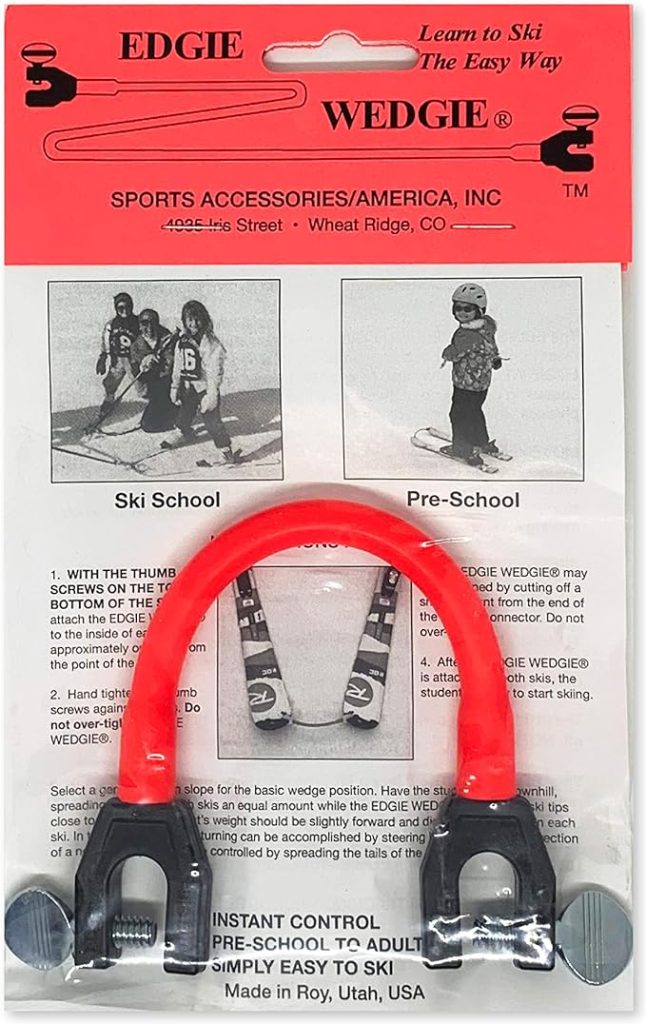
Ski tip connectors are elastic straps that connect the tips of the skis, preventing them from splaying apart. They help in maintaining a “pizza” or snowplow position, which is fundamental for beginners learning to control their speed and direction.
- Advantages: They are simple, inexpensive, and can help children feel more in control.
- Considerations: They don’t offer the same level of parental control as a harness, and some ski schools may discourage their use as they can become a crutch, delaying the development of independent skiing skills.
2. Ski Poles:
While usually recommended for older kids, ski poles can sometimes be introduced to younger kids to help with balance.
- Advantages: They can assist with balance and propulsion.
- Considerations: They require more coordination and can be an added responsibility. It’s essential to ensure the poles are the right size and that the child is ready to use them.
3. Hands-on Assistance:
Some parents opt for direct, hands-on assistance, skiing backward in front of their child and holding their hands or using a hold of their ski poles to guide them.
- Advantages: Direct control and immediate feedback can be given. It can also be a fun and bonding experience.
- Considerations: It can be physically demanding for the parent, and there’s a risk of both parent and child falling together.
4. Ski Schools & Classes:
Many ski resorts offer ski classes specifically designed for young children. Instructors are extremely experienced with kids and ways to get children up to speed with skiing very quickly.
- Advantages: Kids learn from professionals trained to teach skiing techniques. It also allows them to learn with peers, which can be motivating.
- Considerations: It can be more costly than self-guided methods and might not offer the one-on-one attention some children need.
5. Tow Ropes & Conveyor Belts:
Some beginner slopes have tow ropes or conveyor belts – often called “magic carpets” – to help kids get up the hill without the challenge of a chairlift.
- Advantages: It’s easier for kids to use and can save energy, allowing them to focus on learning to ski down the slope.
- Considerations: These are generally limited to beginner areas, so as the child progresses, they’ll need to learn to use chairlifts.
While ski harnesses provide a controlled environment for toddlers on the slopes, the alternatives mentioned can also offer valuable learning experiences. The best choice often depends on the child’s comfort level, the parent’s skiing ability, and the desired learning outcome.
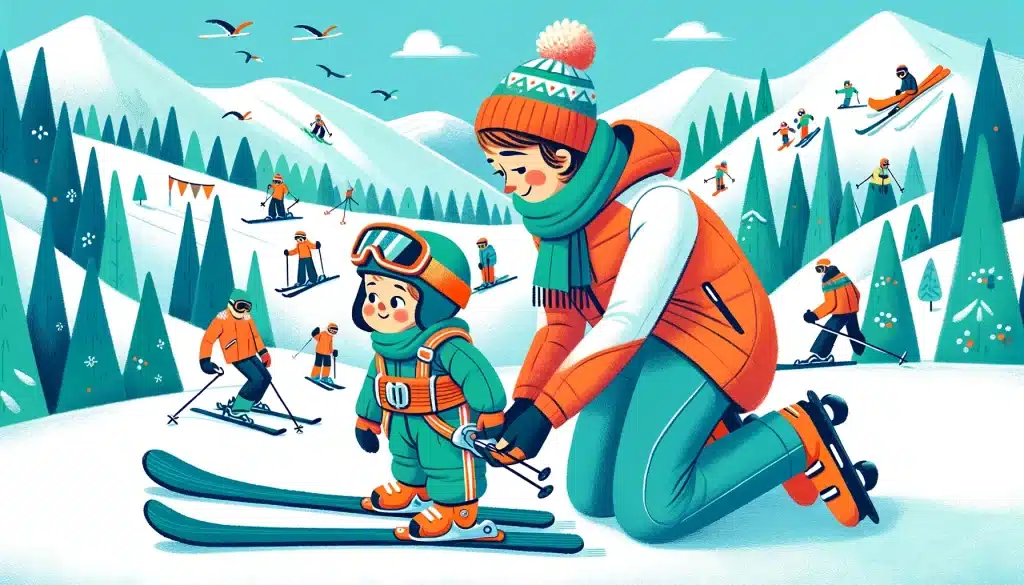
Tips for Teaching Toddlers To Ski
Introducing young kids to skiing can be an exhilarating experience. But as with any sport, the learning process demands the right tools and methods. For many, a kids ski harness is a great way to kickstart this journey. Yet, as any seasoned ski mom or dad will tell you, there are other great ski training tools to enhance this adventure. Here’s a curated list of recommendations, tips, and insights tailored for your little ski enthusiast:
- Start Simple: Before diving into real ski boots and their own skis, consider introducing toddlers to plastic skis. They’re a great way to familiarize kids with the feeling of skis on their feet. Plus, on a gentle slope or flat terrain, they can begin understanding basic movements.
- Harness the Power of Ski Gadgets: The ‘lil’ ripper gripper’ and the ‘ski harness trainer’ are among the best kids’ ski training tools available in North America. With features like retractable leashes and an easy lift handle, they ensure the little ones maintain a correct ski stance. Products with adjustable shoulder straps ensure a perfect fit, and a reinforced handle offers better balance and control.
- Location Matters: If you’re hitting a ski resort for the first time, the bunny slope is a great place to begin. Here, the magic carpet can be a more accessible alternative to the chair lift, especially for first-timers.
- Teaching Techniques: A hula hoop held in front of your child can serve as an innovative teaching tool, ensuring proper hip placement and better upper body alignment. Using slope ropes or a kids ski leash can also be a great idea. For parents seeking a more hands-on approach, skiing backward, and facing their child, can be a great way to provide immediate feedback.
- Avoiding Bad Habits: It’s a good idea to occasionally seek the guidance of ski trainers at your local resort. These experts can identify and correct bad habits, ensuring your child skis with the right techniques.
- Safety First: When teaching kids, especially during the first season, remember safety hazards like shock absorbers and bungee attachments around your husband’s legs can pose risks. Always prioritize safety tools like the child ski harness or snowboard harness trainer. Plus, keep in mind small things like lip balm and hand warmers to make the ski day comfortable for your small kid.
- Deals and More: Ski season can be pricey, but with a bit of research, you can find great deals on child skis and ski gadgets. While some of our suggestions might contain affiliate links, we are firm believers in providing honest, practical advice for your skiing journey.
- Trust Your Instincts: You’re the best judge of your child’s pace. Whether they’re on the ski hill or flat areas, it’s essential to ensure they’re having fun the entire time. The end of the day should always bring smiles, and if that means fewer runs and more cocoa breaks, so be it!
By weaving in these great tips and utilizing the best ski training tools, you’re setting the stage for a lifetime of snowy adventures for your little ones. Remember, skiing is as much about the journey as it is about the destination, and there’s no better time than a young age to embark on this exciting path.
Wrapping Up The Best Ski Harness For Toddlers
Introducing toddlers to the joys of skiing can be a rewarding experience for both the child and the parent. A ski harness stands as a testament to a parent’s commitment to ensuring their child’s safety and confidence on the slopes. By selecting the right harness, properly using it, and being vigilant about potential challenges, parents pave the way for many memorable skiing adventures ahead. As always, the goal is to balance safety with the joy of learning, allowing your toddler to explore the snowy terrain with excitement and assurance.

